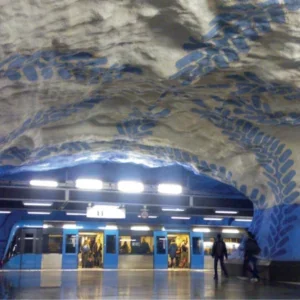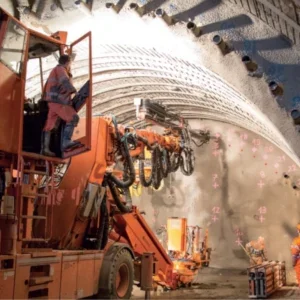How many years from now could a person living in Washington, D.C., see a play or have dinner in New York after work without booking a hotel for the night?
That’s an extreme example, admits David Henley, but it’s not impossible for him to imagine. He’s the project director for Northeast Maglev, the 100 per cent US-owned company, headquartered in Maryland and working to bring super conducting Maglev technology to the US. The project focuses first on a Baltimore to D.C. rail line, providing a 15-minute journey, which would require significant tunnelling. Eventually the company envisions trains flying up and down the entire northeast corridor–doing New York to D.C. in an hour’s journey.
“There are so many different, creative opportunities and untapped potential for the economy,” he says. Adding that there is limitless potential of what this can do for people’s livelihoods. For example, imagine a transportation option allowing someone to live in Baltimore and work in Philadelphia (currently about a two-hour drive).
Like a plane
Super conducting Maglev is a magnetic levitation railway system based on the principle of magnetic repulsion between the track and the cars, developed by high speed rail operator Central Japan Railway Company (JRC). The company says its L0 Series train is the fastest train in the world, reaching the 600km/h mark and setting a speed record for rail vehicles at 603km/h (375 mph).
Unlike conventional railway systems, the SCMaglev accelerates and decelerates not by adhesion between wheel and rail, but through magnetic force generated between the onboard superconducting magnets and ground coils. This enables stable levitation and ultra-high-speed commercial passenger travel routes that exceed speeds of 500km/h (311 mph). The company says by operating completely separated from any surface at high speeds, this form of transportation will eliminate the traditional challenges and constraints of rail-based systems.
Henley compares it to flying. He describes the experience as if “you’re floating on a bed of air. There’s no motion, no vibrations. It’s very elegant. It takes the best part of flying and puts it on a train system.”
Who’s who
Northeast Maglev has been around for about seven years and has worked closely with JRC to identify the feasibility of a route between Washington, D.C., and New York.
Separately, there is program within the Federal Railroad Administration (FRA) called the Maglev Deployment Program, which was initiated about 20 years ago to find a route that would make sense for a proof of concept purpose. The D.C. to Baltimore segment has long been shortlisted for this, and a previous attempt through a German-led entity ended in 2003.
A few years ago the federal government put out a notice of funding available with money to develop an EIS, the engineering support for that EIS, and the system familiarization process, which is the predecessor step, “basically the rules of engagement for operating a maglev train,” Henley explains.
In 2016, the FRA awarded USD 27.8M to the Maryland DOT to prepare preliminary engineering and National Environmental Policy Act (NEPA) analysis for an SCMaglev train between Baltimore and Washington, D.C. Baltimore-Washington Rapid Rail (BWRR) is providing preliminary engineering and technical assistance as well as additional funding support, in concert with the FRA grant, for the NEPA process. Aecom is Maryland DOT’s consultant for the project.
Northeast Maglev has agreements with JRC and Japan’s Ministry of Land, Infrastructure, Transport and Tourism, which funds promotional efforts for the project. “We’re very small and our effort is basically to maintain the engineering input for the project as it proceeds through the EIS,” Henley explains. “At some point once the EIS is completed, the route has been defined and finance is in place the BWRR would be the ones developing the operating entity and management system for deploying the system once approved.”
In concert with Maryland DOT Northeast Maglev put in a proposal including funding the typical 20 per cent match, about USD 7M, that would normally be a state obligation. Northeast Maglev is the promotional arm of the project. The EIS is proceeding independently of the company, Henley clarifies, but it is available to provide engineering support.
“Separate and apart from that we have to define what the operating requirements and protocols will be. Working with Japan, we will be developing those in concert with the FRA in the beginning of the year when we kick off the formal system familiarization effort.
“All the rules and regulations intendant to operating any railroad are under the responsibility of the FRA’s office of safety. We need to take the existing requirements and regulations from Japan and have those adapted or Americanzed here.” That process, which he says, is going forward, will probably take two to three years.
In terms of funding and financing that’s yet to be decided. Henley says there has been interest from Japan Bank. “We would be issued low interest infrastructure loans, which we’d have to pay back. We’re looking for a corollary effort from the FRA through their RRIF [Railraod Rehabilition & Improvement Financing] loan program, which again is low interest infrastructure loans.”
He expects the finance structure may change as the project proceeds over the next year. “We’re very excited. We’re getting close. There are two routes that have been identified and we need to pick one by early next year and then go forward refining that choice. We’re seeing light at the end of the tunnel.”
Underground construction
Of the previously canceled German program from 15 years ago Henley says there are important lessons learned: “The most significant thing we learned was their deployment strategy was an at-grade corridor, which is hugely impactful on localities, and was very unpopular. One of the reasons it got dropped is because of that rather mounting effort against the project on the local level. The FRA went through all the way to the EIS but it stalled after there was so much dissension about it in Maryland.”
From 12 initial alignments FRA and Maryland DOT recommended earlier this year moving forward with two alignments (Figure 1), both which have significant tunnelling components. The corridor is 35 miles (56km) and depending on which alignment is chosen there could be up to 75 or 82 per cent underground (see Table 1). The eastern alignment has less proximity to homes compared to the western alignment. The western would be more expensive due to the increased tunnelling. The tunnel sections will be constructed using TBMs with a typical depth of 80 to 170ft (24 to 52m).
“Obviously 75 per cent to 82 per cent adds a lot of cost to the project but it also avoids a lot of the shortcomings of the prior effort, which was at grade,” Henley says.
“Because of our need to maintain speed, we have to have very rigid geometrics, so those are the predicate for the selection process. What we’ve come up with are the best two versions of what we started out with and I think the least disruptive and have the least implications as far as public impact.”
Considering and averaging the two different alignments, for the sake of this article, he uses an estimate of roughly 28 miles (45km) of tunnelling, which would translate to a seven-year construction period, with at least six but probably likely to be eight TBMs, around 50ft (15m) in diameter, with some 10 million cubic yards of spoil.
“We’re working through the transport routing plans–if it’s by truck–but we’re also, luckily enough, close to CSX freight lines, and we’ve started discussions with them about using rail cars. It’s a massive effort.”
Regardless of the alignment chosen, these will be single bore tunnel drives of approximately 43ft (13m) internal diameter. Figure 2 shows a typical cross section. The design criteria are established to guide the geometry of the alignments and are based on established minimum geometric and operating standards developed by JRC including factors such as passenger comfort and aerodynamics (Table 2).
The tunnel cross section and the decision to do a single bore is based on JCR’s technology. There is such a quantity of pressurized air moving around the tunnel to enable operation the cross section needs to be large enough to accommodate the aerodynamic requirements, he explains. “There’s a lot of tried and true effort and testing throughout the last 25 years in Japan that took them to that decision. We’re standing on the shoulders of a huge amount of investigation and trial and error, and we’re very grateful for that.”
Most of the tunnel boring testing performed so far has confirmed the ground conditions will have a mixture of clay, silts and sands. “In terms of what you’d want in terms of tunnel boring ground conditions we’re in the lucky side of it,” he says.
Looking at the sewers under construction in Washington D.C. over the last decade he says DC Water’s tunnels are bored at similar depths–80 to 100ft. “They’re not running across any issues. Those same ground conditions are basically verified between there and Baltimore. So we feel happy about what we’ve learned so far with through the boreholes we’ve done over the last few months.”
He expects to be putting out a number of very large, design-build contracts to the tunnelling industry in late 2020/ early 2021. “We’re trying to get the word out so people are prepared far enough in advance, so they know this will be coming along. It’ll be at least five to six years of construction. We’re going to allow at least a year of testing of the trains before going into actual revenue service.
They expect this will be international competition and welcome American firms. They are also creating Maryland-based opportunities. “We’re already approaching colleges and high schools with S.T.E.M. programs so that people become aware at the earliest stages, and hopefully the universities can orient their curriculum to focus on jobs that will be coming up, and not just construction jobs but also in terms of operating of the system, which are very specialized jobs, and also at the ground level: inspection, operation of station, maintenance, etc., to bring around a Maryland-based focus because the work is going to be in Maryland we want to have Maryland receive the benefits to the maximum extent possible. But this is very much international project in terms of its focus and the expertise that is going to be required.
“And this is just the initial segment. We’re going to be proceeding northward as soon as we get our record of decision, we’re going to be moving on to our next segment. This is an ongoing effort that is going to be a generation of work, and multiple generations of benefits.”
Asked to address criticism that the project is too expensive or is too big to ever come to fruition in the US. Henley plainly states, the time has come. “There’s a cost of not doing anything,” he says.
“It’s easy to be a defeatist and to be cynical.” He explains, the northeast corridor is its own economy, citing statistics “one of every five dollars is generated in this area. It’s really just 2 per cent of the landmass of the US and it’s growing,” but yet it’s disconnected and that cost of not doing anything is a huge amount of wasted time. There’s a cost in the existing highway, airline and rail infrastructure that’s currently substandard, and to maintain it. There’s the cost of being unable to accommodate the expected population growth.
“It doesn’t make sense to not do anything. We have the technology, we’ve done the critical first stage analysis that show that there are no fatal flaws in terms of the actual deployment potential, financially there’s a market there.
“We’ve done very sophisticated ridership and revenue analysis, which bear out the mark. There’s pent up demand for people wanting time-certain travel, and they will pay more for it.”
He adds, “we don’t have to really think too hard about it. It’s a technology that works and can work here if we have the initiative and the commitment to deployment. It’s long overdue, and once the first segment done, the other parts will happen much more quickly.”
Twice he’s traveled to Japan and had the opportunity to experience SCMaglev technology. He describes a train full of people who are not looking out the window, but rather staring at a speedometer at the front of the carriage.
“As it’s climbing from 100 to 150 to 200 and you’re just waiting for that magical moment, when it reaches its cruising speed of 311 miles/hour, and when it gets up to that everyone just sort of looks at each other, has a big smile. And then everyone wants a selfie, and stands up.
“It’s funny you would think just intuitively you may be standing up when it’s 100 mph but you’d be seated when up to 300 mph?
“It doesn’t really matter. You’re flying. you’re floating on a bed of air.”






